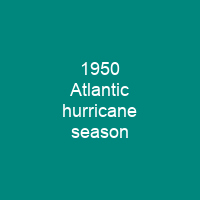The 1950 Atlantic hurricane season was the first in the Atlantic hurricane database that storms were given names. It was a very active season with sixteen tropical storms, with eleven of them developing into hurricanes. Six of these hurricanes were intense enough to be classified as major hurricanes. Eight tropical storms or hurricanes formed in October, which is greater than in any other year. The tropical cyclones of the season produced a total of 88 fatalities and USD 38. 5 million in property damage.
About 1950 Atlantic hurricane season in brief

The storm that caused the highest 24-hour rainfall total recorded in the U.S. was Easy, while King struck downtown Miami as a Category 4 hurricane and caused USD 27. 75 million of damage. In total, there were sixteen tropical storms during the season, of which five did not attain hurricane status. One storm was unnamed and was originally excluded from the yearly summary, and three additional storms were discovered in re-analysis. Before the end of August, four hurricanes had formed, two of which attained major hurricane status; a major hurricane is a tropical cyclone with winds of at least 111 mph ; a storm of this intensity would be classified on the Saffir-Simpson Hurricane Scale introduced in the 1970s. In contrast to the busy August, only three named storms developed in September, although three of the August hurricanes lasted into September. Eight tropical storms or hurricanes formed in October, which is greater than in any other year. The first storm originated from a tropical wave that exited the west coast of Africa around June or July, with the first storm of that year originating around July or July. Hurricane Hunters made about 300 flights into the Atlantic, the most since the practice began in 1943; in typical years, about 300 of the storms was between two hurricanes, six major hurricanes, and two tropical storms.
You want to know more about 1950 Atlantic hurricane season?
This page is based on the article 1950 Atlantic hurricane season published in Wikipedia (as of Nov. 21, 2020) and was automatically summarized using artificial intelligence.







